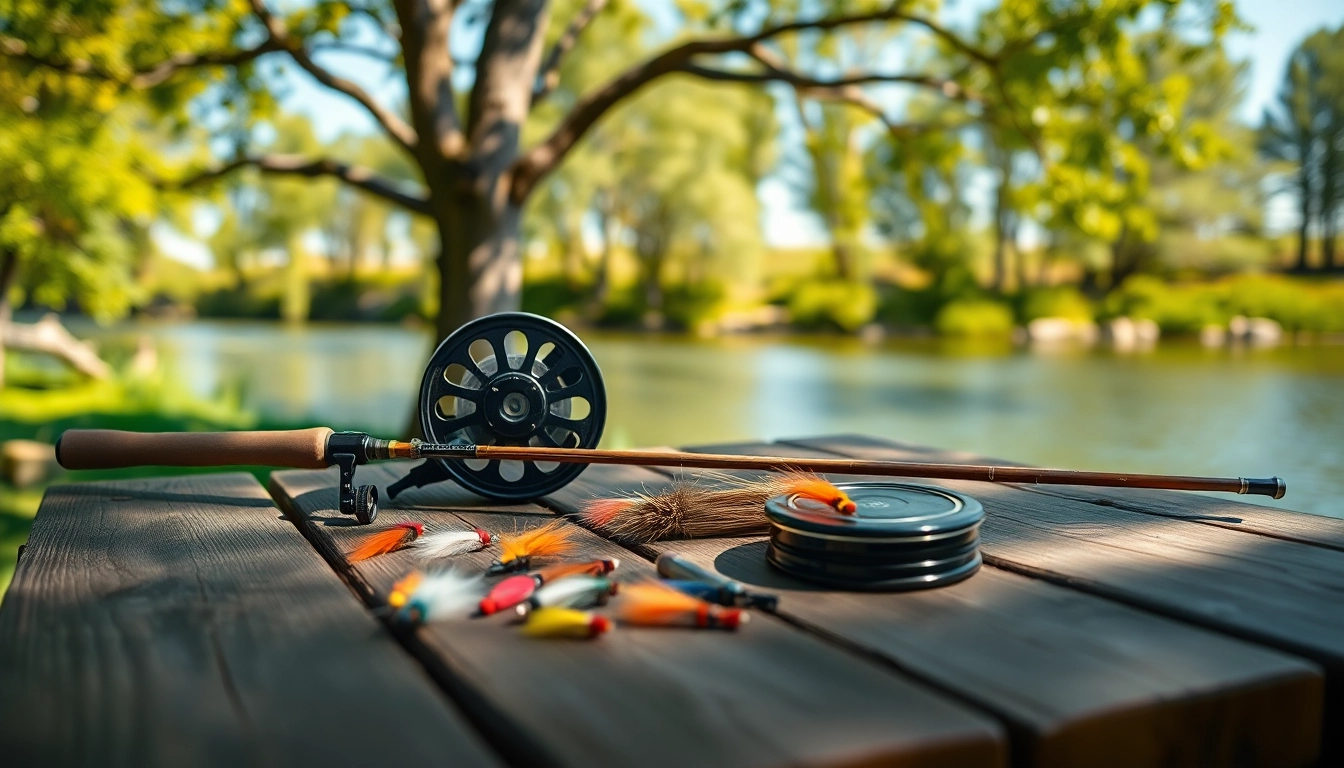Understanding the Basics of Fly Fishing Kit
What Is a Fly Fishing Kit?
A fly fishing kit is a collection of essential gear needed for fly fishing, typically designed to cater to beginners but often containing advanced tools for experience enthusiasts. These kits provide all the components necessary to begin fishing, including a fly rod, reel, lines, flies, and various accessories. The primary advantage of using a fly fishing kit is the convenience it offers novice anglers, helping simplify the process of getting started and ensuring you have everything you need in one comprehensive package. For those interested in diving into the water, investing in a quality Fly fishing kit can set the foundation for a fulfilling fishing experience.
The Key Components of a Fly Fishing Kit
A typical fly fishing kit includes several key components:
- Fly Rod: The rod is designed specifically for casting lightweight flies. It is usually longer and more flexible compared to traditional fishing rods.
- Fly Reel: This device is used to store the line as well as assist in retrieving it during fishing. Many complete kits feature reels matched to their rods for optimal performance.
- Fly Line: Essential for casting, fly lines are specifically designed for the unique dynamics of fly fishing. They provide the weight necessary to cast the lightweight flies.
- Leader Line: This is a thinner line that connects the fly to the fly line, allowing for more sensitivity and better presentation of the fly.
- Flies: The actual bait in fly fishing, flies come in various forms, representing different insects or baitfish. The type of flies included often varies based on fishing conditions.
- Accessories: Depending on the kit, additional items like a tackle box, nippers, forceps, and even a small instructional guide may also be included.
How a Fly Fishing Kit Benefits Beginners
For beginners, a fly fishing kit presents a structured approach to getting into the sport. These kits eliminate the overwhelming aspects of selecting individual components. By providing a tailored setup, new anglers can focus on mastering techniques rather than worrying about the appropriateness of their gear. Furthermore, a comprehensive kit often includes accessories that enhance the overall fishing experience. This sets beginners on a successful path, allowing them to enjoy the tranquility and excitement of fly fishing right from the start.
Choosing the Right Fly Fishing Kit for Your Needs
Factors to Consider When Selecting a Fly Fishing Kit
Selecting the right fly fishing kit involves considering multiple factors that impact your fishing experience:
- Skill Level: Novices should look for kits labeled as “beginner-friendly,” which usually feature easier casting rods and more forgiving reels.
- Target Species: Understanding what species you plan to fish for can help determine the appropriate weight and length of the rod and the type of flies to include in your kit.
- Water Conditions: Kits designed for freshwater and saltwater use different components. Ensure your kit suits the environment in which you plan to fish.
- Versatility: Some kits are designed to cover a range of situations. Depending on your plans, invest in a kit that offers flexibility to fish in multiple environments.
- Budget: Fly fishing kits come in various price ranges. Establishing a budget will help narrow down choices, ensuring you acquire quality equipment without overspending.
Understanding Different Types of Fly Fishing Kits
Fly fishing kits can be categorized based on their intended use:
- Beginner Kits: These kits are user-friendly, often including instructional material, and have equipment tailored to ease the learning curve.
- Specialty Kits: Tailored for specific environments or species, these kits come with specialized rods, reels, lines, and flies for targeted fishing.
- Saltwater Kits: Designed for saltwater anglers, these kits feature corrosion-resistant components and heavier lines suited for larger fish.
- Travel Kits: These compact kits are designed for portability, generally containing shorter rods and foldable reels for easy transport.
Budgeting for a Quality Fly Fishing Kit
Budgeting effectively for a fly fishing kit involves understanding the various price ranges and what they typically include. Beginner kits can start as low as $100, while premium kits may exceed $500. It is important to balance cost and quality; often, spending a little more can greatly enhance the overall experience and longevity of the equipment. Consider allocating funds for accessories not included in some kits, such as waders or a fishing vest. Ultimately, investing in a quality Fly fishing kit will enhance your fishing enjoyment and open up a world of outdoor adventure.
Essential Gear in a Quality Fly Fishing Kit
Must-Have Items in Your Fly Fishing Kit
A high-quality fly fishing kit includes several must-have items that ensure you’re effectively equipped for your fishing outings:
- Quality Fly Rod: Look for rods that are both durable and lightweight, making them easier to handle for longer periods.
- Reliable Reel: A quality reel should have a smooth drag system and be easy to operate, allowing for quick adjustments during fishing.
- Suitable Fly Line: Ensure the fly line is matched to your rod’s weight, as this greatly affects casting performance.
- Selection of Flies: A variety of flies that correspond to local fish species increases the likelihood of successful fishing encounters.
- Leader and Tippet Material: These lines are critical for presentations and transferring energy from the rod to the fly.
Optional Accessories to Enhance Your Fly Fishing Kit
Beyond the basics, several optional accessories can vastly improve your fly fishing experience. Some notable add-ons include:
- Tackle Box: A well-organized box allows for easy access to flies and accessories while keeping everything secure.
- Fishing Vest or Pack: These garments help carry essential gear, drinks, or snacks without cluttering your hands.
- Waders and Boots: Investing in quality waders allows one to access deeper waters while keeping dry and comfortable during fishing.
- Fishing Tools: Essential tools such as nippers, forceps, and a fly patch can save time and improve efficiency during fishing.
Importance of Quality Materials in a Fly Fishing Kit
The materials used in components of a fly fishing kit significantly affect performance and longevity. High-quality materials ensure durability against the elements, while specialized gear designed from lightweight yet strong materials enhances performance. It’s advisable to choose rods with graphite or fiberglass construction, reels with aluminum bodies, and lines made of high-quality, abrasion-resistant materials. Investing in quality ensures your kit withstands various fishing conditions and can provide years of use.
Best Practices for Using Your Fly Fishing Kit
Basic Techniques for Beginner Fly Fishers
Implementing the right techniques is crucial for a successful fishing experience. New anglers should take the time to learn and practice the following essential skills:
- Casting Techniques: Start with the basic overhead cast, which involves lifting the rod to the 2 o’clock position before casting forward. Practice this to ensure consistent distance and accuracy.
- Drifting Flies: Allow your flies to naturally drift with the current. Monitor the line closely and be aware of any movements suggesting a fish is taking your bait.
- Setting the Hook: Timing is critical. If you feel a tug, swiftly raise the rod upwards to set the hook securely in the fish’s mouth.
Common Mistakes to Avoid with Your Fly Fishing Kit
Many beginners make mistakes that can lead to frustration or unsuccessful outings. To maximize your enjoyment and efficiency, avoid:
- Overcasting: Beginners often cast too hard. A smooth, controlled motion is often more effective and less exhausting over time.
- Neglecting to Match Gear: Always ensure that your rod, reel, line, and flies are appropriate for the fish species and water conditions.
- Ignoring Local Regulations: Always research and abide by local fishing regulations and seasons. This ensures sustainable fishing practices and helps protect the environment.
Maintaining and Caring for Your Fly Fishing Kit
Proper maintenance of your fly fishing kit is essential for longevity and performance. Regularly check your line for abrasions, clean the reel after every use, and ensure that your rod is stored in a safe place to prevent damage. A well-maintained Fly fishing kit not only enhances your casting performance but can also save you from unwanted expenses in future replacements or repairs.
Resources and Communities for Fly Fishing Kit Enthusiasts
Online Forums and Communities for Fly Fishers
The internet is home to numerous online communities where fly fishers can connect, share experiences, and offer insights. Participating in forums allows you to learn from experienced anglers, seek advice on gear, or simply exchange fishing stories, making it a rich resource for any fly fishing enthusiast.
Recommended Reading and Resources on Fly Fishing Kits
To expand your knowledge about fly fishing kits and enhance your skills, consider diving into literature on various aspects of the sport. Look for books that focus on technique, fly tying, and specific fishing environments. Additionally, instructional videos and documentaries can provide practical insight that complements your hands-on experience.
Local Fly Fishing Shops and Support Networks
Local fly fishing shops often serve as hubs of information and community support. These shops typically offer classes, workshops, and guided fishing expeditions, providing an excellent opportunity to enhance your skills and meet fellow enthusiasts. Building relationships within your local fishing community can provide long-term benefits, from obtaining tips on the best fishing spots to getting recommendations for gear upgrades.



